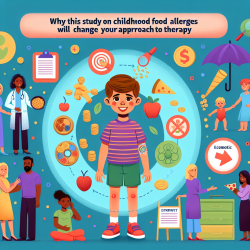Understanding the Economic Impact of Childhood Food Allergies
As a practitioner in the field of speech-language pathology, it is crucial to understand the broader context of the challenges faced by children and their families. A recent study titled The Excess Costs of Childhood Food Allergy on Canadian Families: A Cross-Sectional Study provides insightful data that can enhance your practice and improve outcomes for children with food allergies.
Key Findings from the Study
The study highlights the significant economic burden that childhood food allergies place on Canadian families. Here are some critical findings:
- Higher Direct Costs: Families with food-allergic children incur higher direct costs, primarily due to increased spending on food. On average, these families spend $12,455.69 annually compared to $10,078.93 for families without food-allergic children.
- Indirect Costs: While indirect costs, such as lost wages and time, were lower for food-allergic families, the difference was not statistically significant. This suggests that the economic burden is more heavily weighted towards direct costs.
- Quality of Life: Parents of food-allergic children perceive their child's quality of life to be poorer compared to their healthy peers, highlighting the intangible costs associated with managing food allergies.
Implications for Practitioners
Understanding these economic impacts can inform your practice in several ways:
- Holistic Approach: Incorporate discussions about economic challenges and quality of life into your therapy sessions. This can help build a more comprehensive support system for the child and their family.
- Advocacy: Use this data to advocate for policy changes that could alleviate the financial burden on families, such as subsidizing allergen-friendly foods or providing financial support for medical expenses.
- Further Research: Encourage further research into the economic impacts of food allergies in different regions and demographics to better tailor interventions and support systems.
Encouraging Further Research
While this study provides valuable insights, it also opens the door for further research. Practitioners can contribute by documenting their observations and outcomes related to the economic impacts of food allergies. Collaborating with researchers can lead to more comprehensive data and potentially influence policy changes that benefit families.
To read the original research paper, please follow this link: The excess costs of childhood food allergy on Canadian families: a cross-sectional study.










